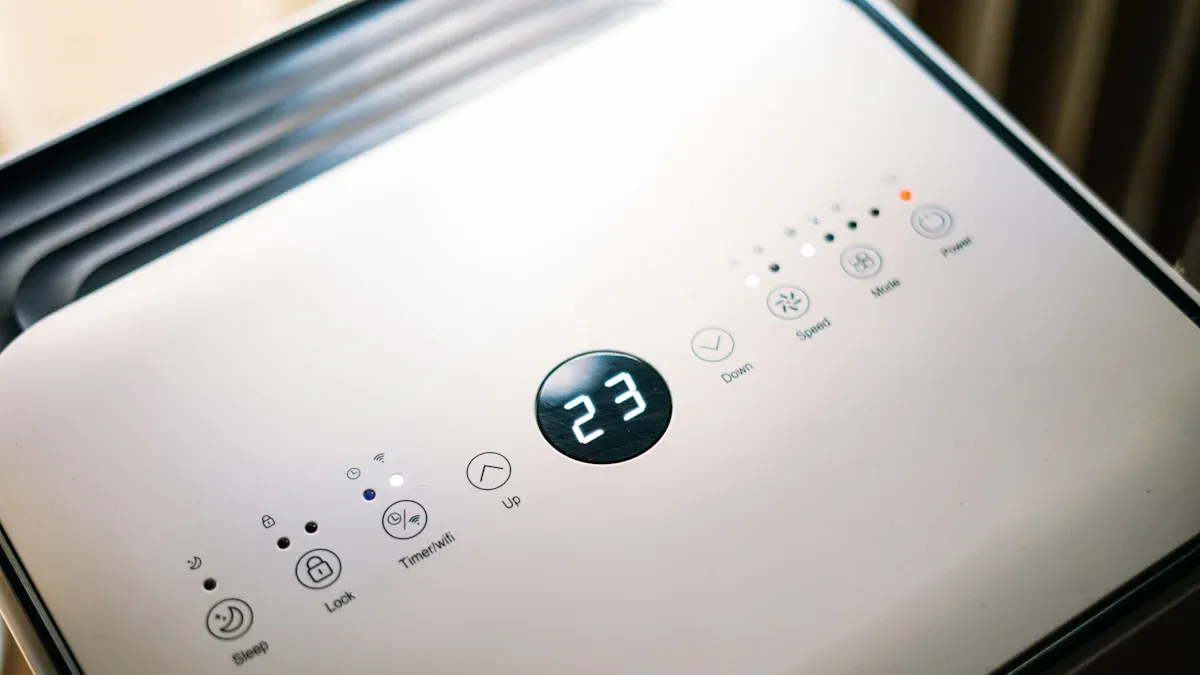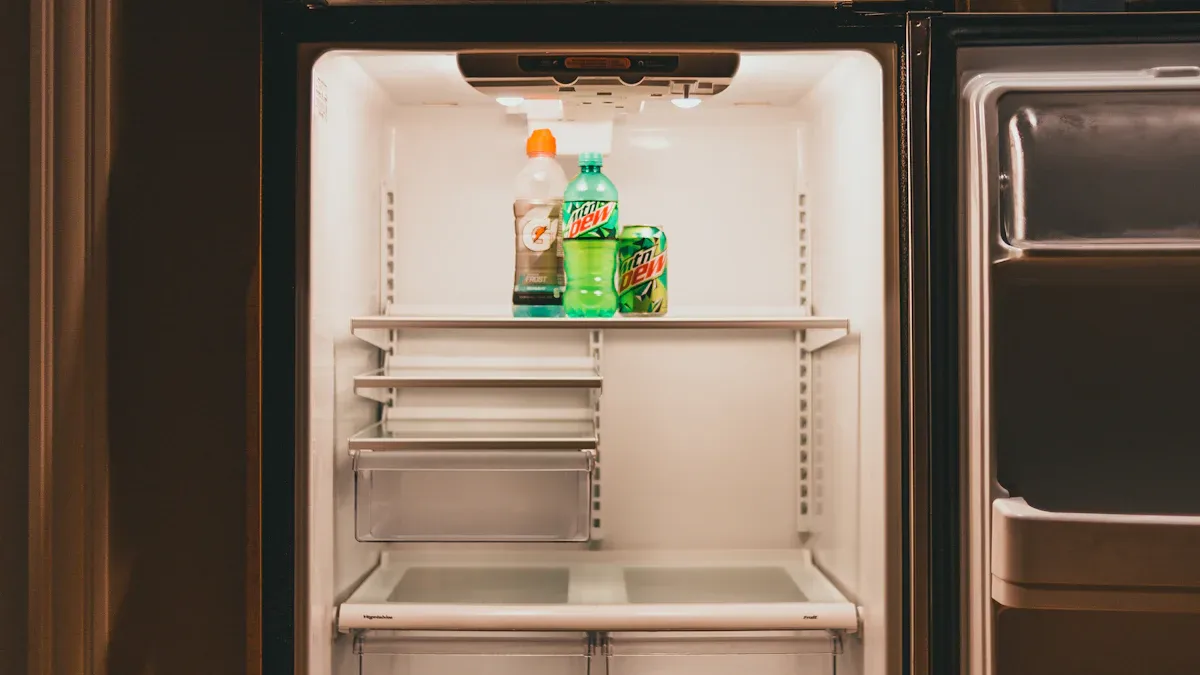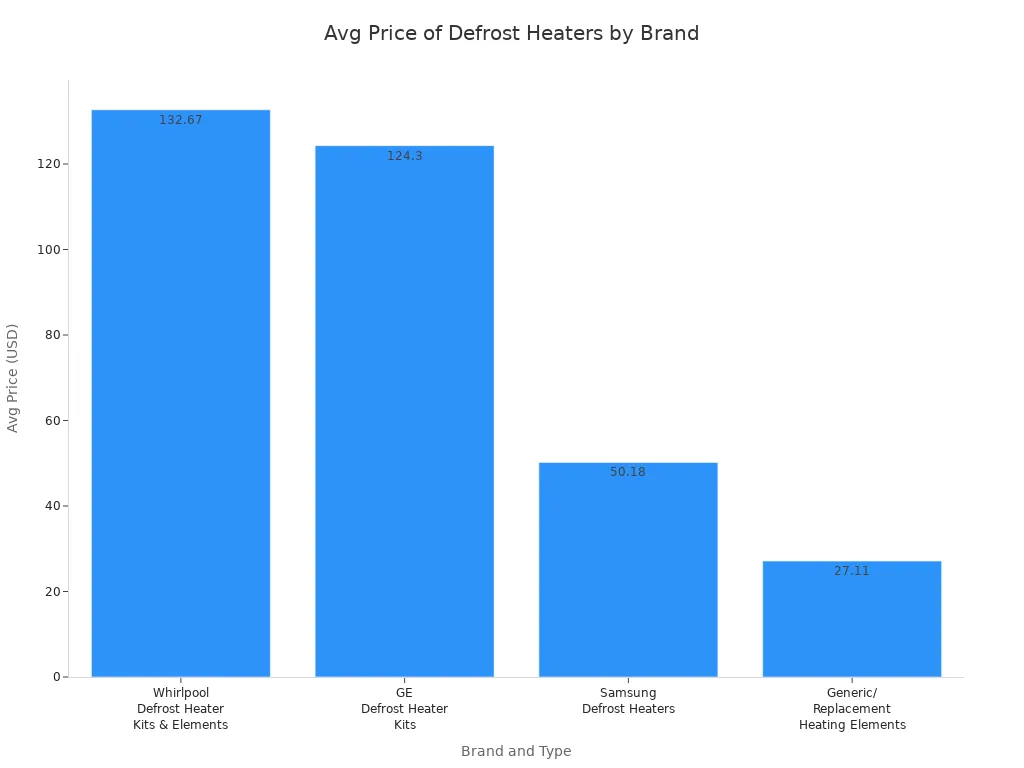
Choosing the correct refrigerator defrost heater protects both food and appliance. Many industry studies show that the right defrost heater element lowers energy use and reduces wear.
| Aspect Evaluated | Impact on Appliance Performance |
|---|---|
| Defrost heater type | Higher efficiency means less energy used and longer lifespan. |
| Power optimization | Proper wattage avoids wasted energy and keeps fridge safe. |
A fridge defrost heater that matches the model number ensures the defrost heating pipes and controls work as designed.
Key Takeaways
- Find your refrigerator’s model and serial number to ensure you buy a defrost heater that fits perfectly and works well.
- Check the heater’s voltage, wattage, size, and shape to match your appliance and improve energy efficiency and safety.
- Choose high-quality or OEM parts for better durability, reliable performance, and fewer repairs over time.
Identify Your Refrigerator Defrost Heater Requirements

Locate Model and Serial Number
Finding the correct model and serial number is the first step in selecting a refrigerator defrost heater. Most refrigerators display this information inside the fresh food compartment. Users often find the label on the bottom floor, behind or beneath the crisper drawers, or on the side walls near the top. Some brands place the tag on the ceiling area or inside the door frame. Newer models may include a QR code for quick scanning. If the sticker is missing, taking photos and contacting a professional can help identify the appliance. Accurate model numbers ensure the replacement part fits and works as intended.
Check Manufacturer Specifications
Manufacturers provide detailed specifications for each refrigerator defrost heater. These details include the part’s length, type, and electrical characteristics. Comparing these specifications with the original part helps avoid mistakes. Using the model number to search for OEM parts guarantees compatibility. Manufacturer instructions also list resistance values for testing the heater with a multimeter. Matching these values confirms the heater’s function. Always consult the technical documentation before making a purchase.
Understand Your Defrost System Type
Refrigerators use either manual or automatic defrost systems. Manual defrost requires users to turn off the appliance and let ice melt naturally. Automatic systems activate a heating element at set intervals or when sensors detect frost. Most major brands use automatic systems with heaters located beneath the evaporator coils. The type and shape of the heater, such as straight or U-shaped, depend on the refrigerator’s design. Knowing the system type helps select the right refrigerator defrost heater for efficient performance.
Key Factors for Choosing a Refrigerator Defrost Heater

Compatibility and Part Numbers
Selecting a Refrigerator Defrost Heater starts with compatibility. Each refrigerator model requires a heater with specific features.
- Voltage must match the appliance, such as 110V, 115V, or 220V.
- Tube length varies, with common sizes from 10 to 24 inches.
- Tube diameter, often 6.5mm, ensures a proper fit.
- Shape and material, like stainless steel 304, affect performance.
Manufacturers assign unique part numbers to each defrost heater. Users should check the tag on the existing heater and compare the last four digits with the replacement part. This step prevents installation errors. For example, a Samsung DA47-00244W fits only certain models. Cross-referencing part numbers guarantees the new heater will work as intended. Online compatibility tools help users find the right part by entering the refrigerator’s model number.
Tip: Always decode manufacturer specifications carefully. Pay attention to voltage, amperage, part dimensions, and compatibility codes.
Wattage, Voltage, and Heater Type
The wattage and voltage of a Refrigerator Defrost Heater determine its efficiency and safety. Most residential refrigerators use heaters operating at about 115 volts. Wattage usually ranges from 350 to 400 watts, but some models may draw up to 1200 watts during the defrost cycle. The minimum breaker size for these appliances is often 15 amps, which supports a maximum power draw of around 1800 watts.
Heater type also matters.
- Electric resistance heaters use NiCr wire to generate heat.
- Glass tube heaters use NiCr wire inside a conductive glass tube, which increases defrost efficiency.
- Some advanced systems combine electric heaters with air bypass or hot gas methods to reduce energy use.
| Heater Type / Method | Defrost Efficiency | Defrost Time Reduction | Energy Consumption Reduction |
|---|---|---|---|
| Glass Tube Heater | 48% | N/A | N/A |
| Traditional Electric Heater | Lower efficiency | N/A | N/A |
| Electric Heater + Air Bypass | Increased by 77.6% | Reduced by 62.1% | Reduced by 61% |
| Hot Gas Defrost Method | 7.15% more efficient than electric resistance | N/A | Consumes 20.3% less energy than electric resistance |
Quality, Durability, and Energy Efficiency
Quality materials ensure a Refrigerator Defrost Heater lasts longer and works efficiently. Aluminum foil heaters are popular because they conduct heat well and resist corrosion. These heaters have layers of aluminum foil, insulation, and embedded heating wire. They are lightweight, flexible, and provide uniform heating. Intelligent temperature compensation helps prevent excessive freezing and keeps temperatures stable.
- Aluminum heaters distribute heat evenly and rarely damage internal parts.
- Glass tube heaters avoid corrosion but need protective covers.
- Calrod heaters are efficient and easy to install.
Material choice affects durability, heat conduction, and resistance to corrosion. High-quality heaters reduce the risk of breakdowns and help maintain refrigeration efficiency.
Note: Certified parts often include safety features like thermal cutoff switches to prevent overheating. Factory-certified components meet strict quality and engineering standards.
OEM vs. Aftermarket Options
Buyers can choose between OEM (Original Equipment Manufacturer) and aftermarket Refrigerator Defrost Heater options. OEM parts are designed for specific refrigerator models and guarantee perfect compatibility. They often come with manufacturer warranties and meet rigorous quality standards. Aftermarket parts may cost less and fit a wider range of models, but users must verify compatibility carefully.
| Brand | Part Type | Price Range (USD) | Notes |
|---|---|---|---|
| GE, Kenmore | OEM | $8.99 – $16.95 | Some kits around $22.97; low-cost options available |
| GE, Kenmore | Aftermarket | $9.40 – $15.58 | Comparable or slightly lower than OEM base prices |
| GE | OEM (Premium) | $209.99 | High-end OEM part, significantly more expensive |
| Frigidaire | OEM | $15.58 – $48.00 | Mid-range OEM pricing |
| Monogram | OEM | $78.19 – $116.06 | Premium or specialized parts |

Premium OEM parts, such as those for Monogram, cost more but offer high durability and compatibility. Aftermarket options provide budget-friendly alternatives, especially for older or less common models.
Where to Buy and How to Evaluate Reviews
Consumers can purchase Refrigerator Defrost Heaters from appliance parts stores, authorized dealers, or reputable online retailers. When shopping online, users should read product descriptions carefully and check compatibility tools. Customer reviews provide insight into product quality, ease of installation, and long-term performance.
Tip: Look for reviews that mention the specific refrigerator model and installation experience. Verified purchase badges add credibility to reviews.
Price ranges vary by brand and type. For example:
| Brand | Type | Price Range (USD) | Example Part Numbers & Prices |
|---|---|---|---|
| Whirlpool | Defrost Heater Kits & Elements | $44.00 – $221.34 | WR51X442 ($77.42), WR51X466 ($221.34) |
| GE | Defrost Heater Kits | $115.00 – $133.59 | WR51X464 ($115.00), WR51X465 ($133.59) |
| Samsung | Defrost Heaters | $45.35 – $55.01 | DA47-00244D ($55.01), DA47-00322J ($45.35) |
| Generic/Replacement | Heating Elements | $24.43 – $29.79 | WP61001846 Whirlpool Heater ($24.43) |

Choosing a reliable supplier and reading detailed reviews help buyers avoid counterfeit or low-quality parts. Certified sellers often provide better after-sales support and warranty coverage.
A Refrigerator Defrost Heater that matches the appliance keeps the refrigerator running well. High-quality parts offer many benefits:
- Regular defrosting stops ice from blocking cooling ducts.
- Consistent temperature protects food and parts.
- Fewer repairs save money over time.
FAQ
How often should someone replace a refrigerator defrost heater?
Most defrost heaters last several years. Replacement becomes necessary if the refrigerator shows signs of frost buildup or stops cooling properly.
Can a homeowner install a defrost heater without professional help?
Many homeowners can install a defrost heater by following the manufacturer’s instructions. Safety precautions and proper tools help ensure a successful installation.
What signs indicate a faulty defrost heater?
Common signs include frost buildup, inconsistent cooling, or water leaks inside the refrigerator. These issues suggest the defrost heater may need replacement.
Post time: Jul-22-2025




